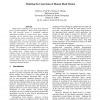Free Online Productivity Tools
i2Speak
i2Symbol
i2OCR
iTex2Img
iWeb2Print
iWeb2Shot
i2Type
iPdf2Split
iPdf2Merge
i2Bopomofo
i2Arabic
i2Style
i2Image
i2PDF
iLatex2Rtf
Sci2ools
HUMO
2000
Springer
2000
Springer
Modeling the Constraints of Human Hand Motion
Hand motion capturing is one of the most important parts of gesture interfaces. Many current approaches to this task generally involve a formidable nonlinear optimization problem in a large search space. Motion capturing can be achieved more cost-efficiently when considering the motion constraints of a hand. Although some constraints can be represented as equalities or inequalities, there exist many constraints, which cannot be explicitly represented. In this paper, we propose a learning approach to model the hand configuration space directly. The redundancy of the configuration space can be eliminated by finding a lower-dimensional subspace of the original space. Finger motion is modeled in this subspace based on the linear behavior observed in the real motion data collected by a CyberGlove. Employing the constrained motion model, we are able to efficiently capture finger motion from video inputs. Several experiments show that our proposed model is helpful for capturing articulated m...
| Added | 24 Aug 2010 |
| Updated | 24 Aug 2010 |
| Type | Conference |
| Year | 2000 |
| Where | HUMO |
| Authors | John Y. Lin, Ying Wu, Thomas S. Huang |
Comments (0)

